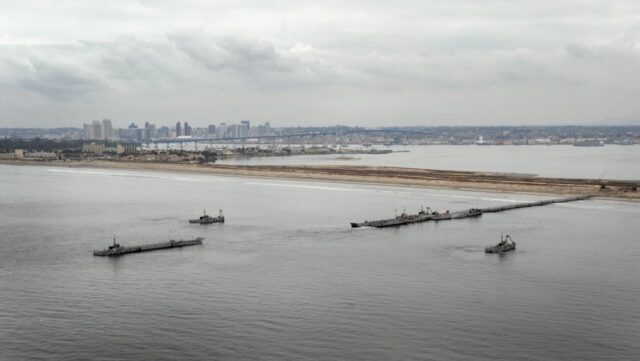
Reporting that ramped up from 6 to 7 March 2024 indicates President Joe Biden is to announce in his State of the Union (SOTU) address Thursday night that the U.S. military will be building a temporary pier off the Gaza coast to facilitate delivery of aid by sea. (Update: he did announce it.)
Reaction to this news is decidedly mixed. Critics point out, among other things, that aid delivered by sea will face the same hurdle it faces when delivered by land. Hamas will seize it first. It won’t get to Gazan non-combatants who may need it.
There is no reason to hope otherwise. The reports on this development state that the Biden administration won’t be putting U.S. personnel ashore, which means the U.S. won’t have a security presence for escorting the aid. Reactions suggest most Americans don’t want that anyway. Putting American service members between the aid and armed Hamas terrorists doesn’t sound like a good idea.
Some reporting suggests that Israel will handle security for the sea-delivered aid ashore. Politico, however, claims that that’s not a done deal yet: “U.S. officials said Israel has not yet agreed to a security and crowd-control mission on the beachhead and that negotiations are ongoing, including whether Israeli forces would also be responsible for demining staging areas for the aid.”
The delivery is to be executed by the UN and NGOs.
As always, let us visit the map. According to Human Rights Watch, about half of the displaced Gazans in Gaza are now in Rafah. In general, given the combat progress of the IDF, the flow of displaced persons in Gaza has been north to south. It has been reported that many are currently between Rafah, Khan Yunis, and the border with Israel.
Rafah is also Hamas’s last hideout and operating base in Gaza; Israel needs to execute operations there to finish neutralizing Hamas and free the entire Gaza Strip. In recent days, the IDF has been concentrating on clearing and securing Khan Yunis.
This military situation – the IDF and Hamas fighting right in the area where the aid needs to go – would make delivering aid trickier, of course. That’s a reality at varying levels throughout Gaza. But it also poses the question where the U.S. wants to put the temporary pier.
Close to the target population seems like an obvious answer. It makes the security problem worse to have to convey the materiel over land for a greater distance.
However, putting the pier, say, here, would be far from ideal.
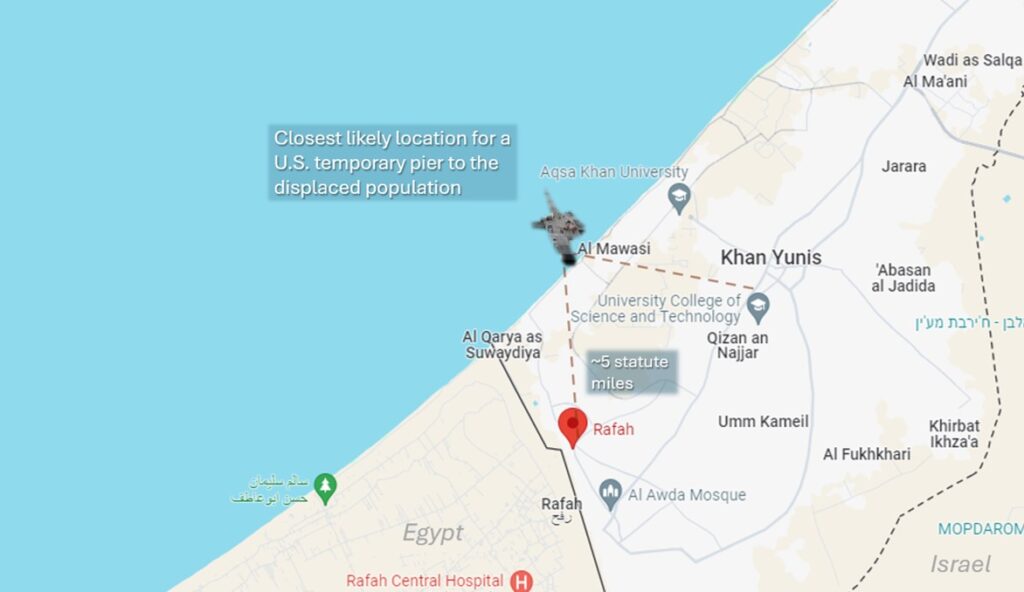
Besides making the temporary pier an easy target for Hamas close to the Gaza shore, that location – while handy to the road system – would mean the loading of aid convoys would take place in an especially vulnerable location near the fighting.
One potential location might be the pier known as “Khan’s new port” (the new pier constructed in the last decade near Khan Yunis), seen in the image on the coast northwest of Khan Yunis. The IDF seized the pier in February; it’s not clear if they have retained dedicated control of it. (For their purposes it may suffice to monitor it from offshore.)
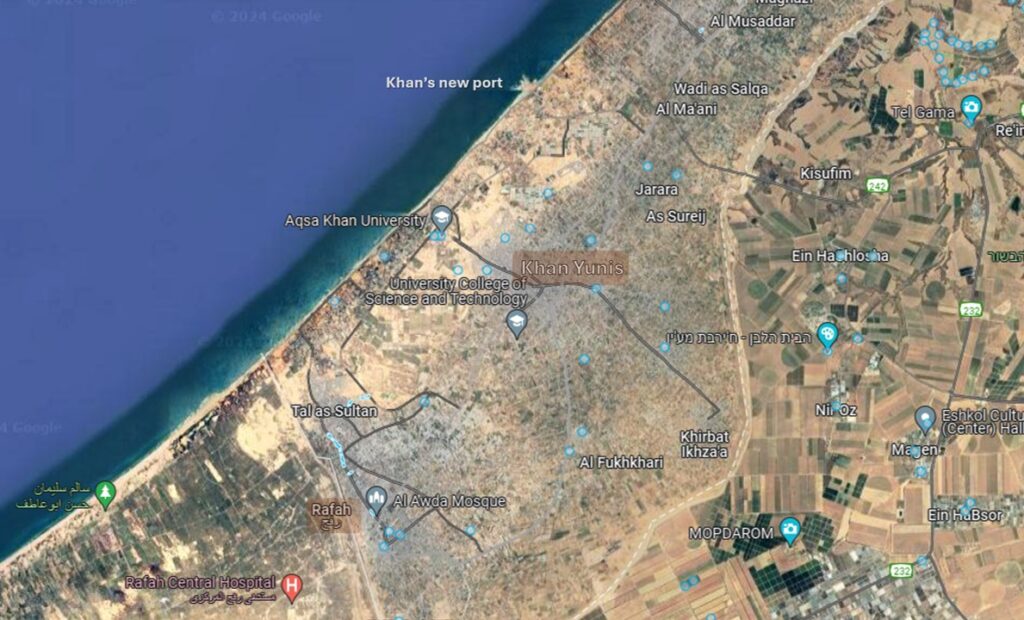
The pier is not in good working order in the recent images of it but may retain enough integrity to be connected with. There are no real port facilities. They would have to be provided, as indeed they would have to be provided anywhere along the coast where the temporary pier was situated. If the US is not to put boots on the ground, presumably the UN and/or NGOs would provide such infrastructure.

However, the issues of vulnerability at the cargo transfer location, and proximity of the temporary US pier to the fighting for Hamas’s last bastion, would remain.
Further up the coast, there is also a pier at the Gaza City port.
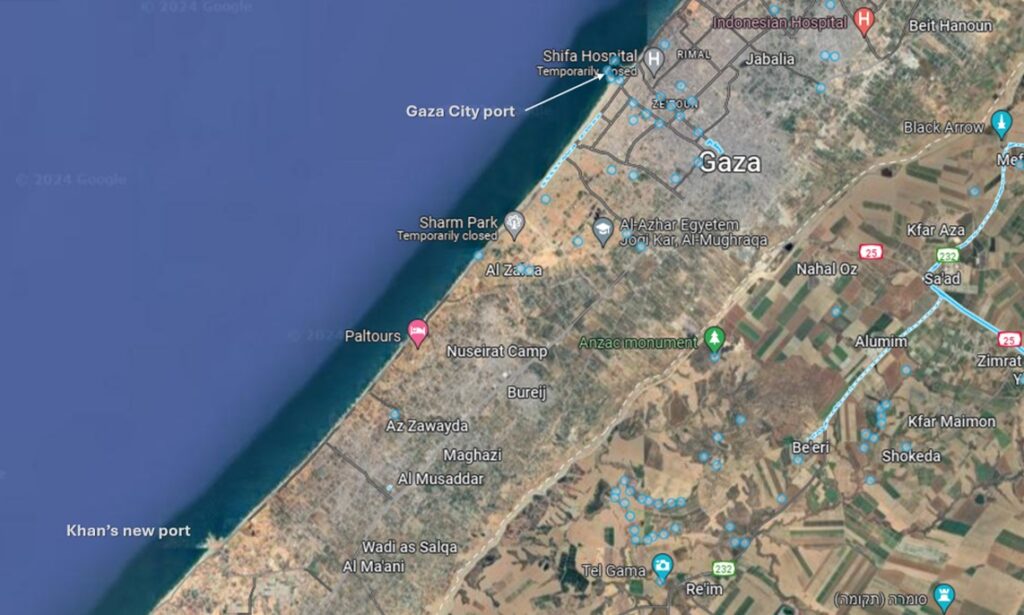
That option, or any between Khan’s new port and Gaza City, would put the sea-shore delivery interface even further from the population in need of aid. The security situation might be marginally improved for aid workers handling the cargo ashore, but the longer road trip would require a larger-scope escort operation for (presumably) the IDF.
Operational Entry Points for “Good Idea” Light Bulbs
That last “presumably” is the crux of a matter that must concern Israel. Escorting aid from multiple entry points will inevitably complicate the operational burden for the IDF. That burden is likely to conflict with pacifying southern Gaza. It’s easy, for one thing, to see how third parties like the US, UN, and European nations could use the operational problem created by the temporary US pier as a pretext for proposing to introduce an outside security force in Gaza.
As much as that would be to Israel’s disadvantage, and the advantage of those seeking to establish the de facto infrastructure of a “Palestinian state” as a follow-on to Hamas’s rule, a greater problem could well be the impact of a US-sponsored aid effort on Israel’s fight to rid southern Gaza of Hamas. The timing of proposals for the US aid arrangement and a lengthy cease-fire is illuminating.
In comments from Vice President Harris, she called for a cease-fire lasting as long as six weeks. (Biden called for the same in the SOTU.) Meanwhile, according to media reporting, CENTCOM expects the installation of the proposed temporary pier to require “weeks.”
Given that temporary piers of the apparent capacity for the Gaza job have been assembled in days, in exercises in the Pacific in recent years (a bit more below), it’s likely that the prediction of “weeks” for the U.S. pier is based mainly on transport time for the elements of the pier system.
Some of the time is probably also related to putting in infrastructure ashore, which would seemingly not be done by the US military. The US could contract with commercial services companies to have that done, or the UN and/or NGOs (or another nation like the UK) could arrange it.
The timing proposals would ultimately appear to make initiation of the pier operations coincide with initiation of Israel’s final push in Rafah – if, that is, there is a weeks-long cease-fire before the Rafah operation starts.
It looks like that’s the effect being pushed for with the cease-fire campaign and the new US proposal in the SOTU.
With nothing set in stone, we can hope that Israel proceeds with defeating Hamas in Rafah rather than delaying that push for a cease-fire.
But the concern remains that a US aid pier would be an entry point for leverage over both Israeli policy on the war, and IDF combat activity.
The Glaring Absence
One reason to take that seriously is the complete silence in media coverage on the relevant point that Israel has a formal maritime blockade of Gaza in effect, a blockade established in January 2009 and maintained ever since. If the US were to breach Israel’s blockade without consulting with Israel, that would have the effect of nullifying the blockade. Israel wouldn’t be able to enforce it, short of resorting to force to eject the U.S. intervention and reimpose the blockade.
As it is, the US reportedly has been consulting with Israel. It isn’t stated anywhere, but we can assume that what the Biden administration is doing is using a humanitarian-aid loophole in customary blockade protocol, which allows the blockading nation to selectively admit humanitarian vessels while maintaining the blockade. (To read up on this and other aspects of the Gaza blockade, see this Israeli government document. I recommend starting on page 51 for the meat of the protocols and expanding your perusal from there. The section in question includes the use of the humanitarian aid exception.)
That there is zero discussion of the blockade strikes me as an information-management effort. The blockade is clearly relevant to the theme the Biden administration is embracing about Gaza being closed off and in need. But it’s not being addressed head-on at all. There are thus no guarantees being implied or explicitly offered of the US posture on the blockade.
If third parties mount new challenges to the blockade once the US pier is in place, like the activist “flotillas” of a decade and more ago, it’s not clear what the Biden administration will do. Keep in mind, the US doesn’t reject the blockade, but neither have we embraced or affirmed it in our own policy. (That’s normal, but it’s also convenient for Team Biden.)
If an activist delivery operation forces us to make an on-scene decision about that, there’s no certainty that the Biden administration would effectively put a US stamp of approval on the blockade by enforcing it at the aid transfer point under our control. The aid shipments are nominally supposed to start from Cyprus, but it would be ridiculous to assume no one will try to circumvent that arrangement and make a rogue run for the US pier.
If at some point Israel perceives the US pier arrangement to put maintenance of the blockade in jeopardy, it’s not clear what the Biden administration will do. I hope Israel is obtaining guarantees on that point. But the silence is worrisome.
The Offshore Enterprise
*UPDATE*: I’m leaving all the previous material from this section in place, as it covers a lot of ground readers will have questions about. The information that the U.S. military will set up the temporary pier system remains common to all the media coverage and appears to point most likely to the Army and the Trident Pier.
Additional information from the Wall Street Journal is illuminating, however. Coordinating the transfer of aid, as throughput for the pier system, will reportedly be contracted to a private company called Fogbow. “The Biden administration is looking to at least one American company, Fogbow, to coordinate deliveries to Gaza through the new maritime corridor using commercial ships, according to Gulf officials and people familiar with the plan.”
Says the Journal: “Fogbow, which is made up of former US government, military and United Nations officials, will lead efforts to secure the ships and coordinate with the Israeli government, the UN and Gazans on the ground, those people said.”
The Fogbow website is here. There are two Fogbow LLC incorporations in the US, one in the California Bay Area in 2023 and one in Wyoming in May 2022. Based on geographic references for the associated businesses of Fogbow principals, I think the Fogbow LLC in Wyoming is the one in question. Interestingly, its corporate documents don’t seem to be retrievable in a search at the Wyoming state website. (The basic information is found at Open Corporates, and all the associated names are of business-services companies. The headquarters address is in Connecticut.)
Otherwise, there is very little information online about the company itself. There’s no “About” page with a company history. There’s a main page with a handful of non-linked descriptive sections, a contact form, and a link to the Team, where the names and brief bios of the principals are found. Fogbow specializes in humanitarian mission work, “executing complex logistical challenges delivering aid in difficult environments to de-mining and UXO removal to effectively respond to humanitarian crises.”
Draw your own conclusions about that. The atmosphere is like other uncommunicative consulting-company sites formed by heavy hitters from special operations and intelligence.
It’s an interesting choice for the task at hand. The company’s youth and secretive profile offer no track record to judge its quality by. The principals come from deep backgrounds, and that seems to be the selling point.
Note, however, this unique recommendation for Fogbow VP and co-founder Mick Mulroy. According to his Wikipedia entry, and sourced to an ABC News story from 18 November 2020, ten days after the election: “In late 2020, during the delay in the transition between the Trump Administration to the Biden Administration, the incoming team for the DoD reached out to several former members of then-Secretary James Mattis for assistance. Mulroy was one of the former officials and one of the few that agreed to assist.”
The reference is to the brief delay in commencing transition activities, mainly agency teams briefing the incoming administration. Mulroy had been Deputy Assistant Secretary of Defense (DASD) for the Middle East from October 2017 to 1 December 2019, so his Pentagon service was a year out of date when he agreed to assist the transition. This is certainly something people can legitimately form differing opinions about, i.e., what the actual nature of the “transition assistance” was.
The ABC story describes it thus: “[S]ources familiar with the matter said that Biden’s team has been in contact with those who have recent experience in various federal agencies, and in most cases the individuals are career officials and not political appointees. It was not clear exactly what information the transition team is soliciting from these former officials, but it was not believed to include classified materials.”
Mick Mulroy is the only one alluded to by name. He clearly cooperated with the ABC story (he was a contributor source for ABC at the time).
“Mick Mulroy,” says ABC, “a former senior Pentagon official who briefed the transition team on Tuesday afternoon, described his participation in the transition process as a patriotic duty — not a political calculation. During his two years in the Trump administration, which ended in December 2019, Mulroy oversaw the Pentagon’s military policy in the Middle East — a valuable area of expertise as Biden and his top aides endeavor to fill key national security positions.”
ABC continues with a quote: “‘The incoming national security team deserves to have the full support of a transition to ensure the seamless transfer of power without incurring any unnecessary risk to our nation’s security,’ said Mulroy, who is currently an ABC News contributor. ‘I am supporting the incoming transition team because it is the right thing to do.’”
So, you know, huh. Among them, the Fogbow principals have a little slew of other consultancies as well.
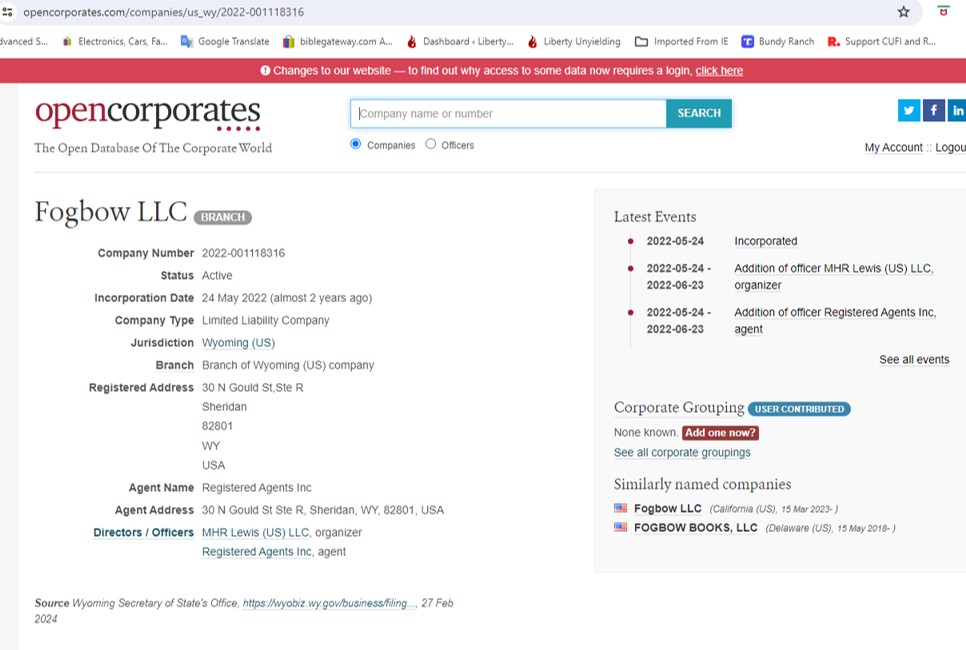
Original text continues:
Though it doesn’t appear that the Marines would be involved in the temporary pier’s construction, media have provided updates on their movements in connection with the news about it.
The USS Bataan (LHD-5)/26 MEU/SOC amphibious group has left the Mediterranean to return home to the US East Coast. There won’t be another amphibious group in the Middle East area for some time, as USS Boxer (LHD-4), a West Coast ship, is delayed due to maintenance problems. (See the Politico link above.)
In the images below, however, the construction activities are being conducted by US Navy and US Army units. No reporting has said that this – the Trident Pier – is the system to be used, but it would fill the requirement we’ve heard stated. The evolution in San Diego involved the Navy’s Amphibious Construction Battalion 1 (Seabees). In the 2015 exercise in South Korea (further below), the US Army’s 331st Transportation Company (Modular Causeway System) performed the set-up. The 331st, out of Ft. Eustis, VA, is part of the 7th Transportation Brigade (Expeditionary), a unit of the XVIII Airborne Corps, and we couldn’t be prouder to report that its motto is “Causeway or No Way!”
A team with the appropriate skills would presumably have to be deployed to the Mediterranean for this task off Gaza; no doubt a feasible requirement and it would simply take some time to marry up with the elements of the pier system.
Although there might also be the possibility of military supervision (probably Army) and a contract insertion by a defense contract team, the language of the reporting so far appears to point to execution by US troops.
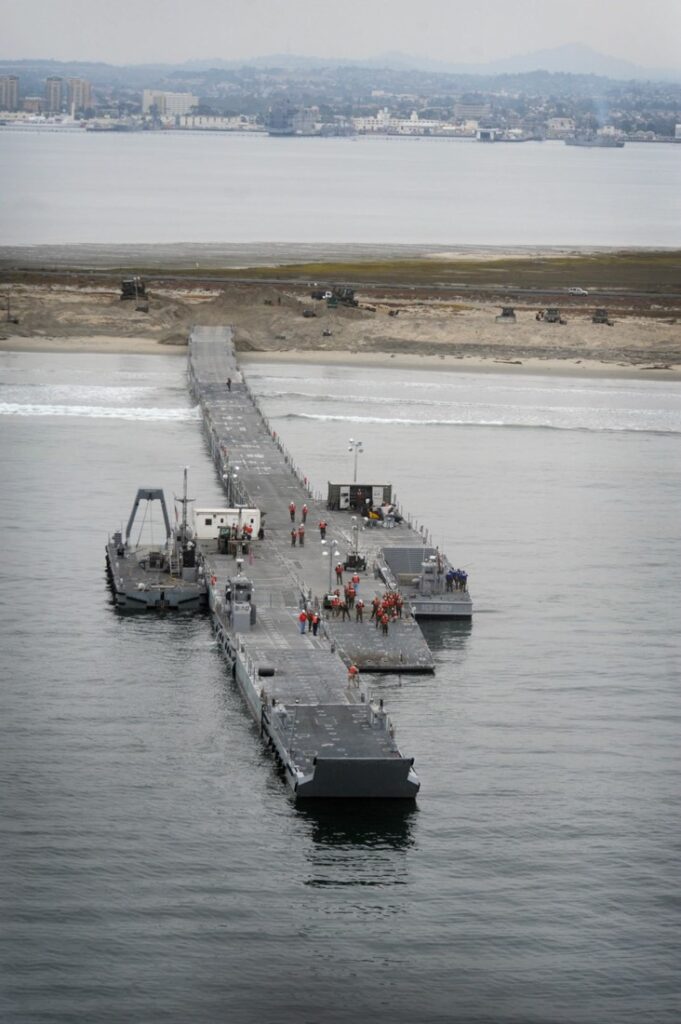
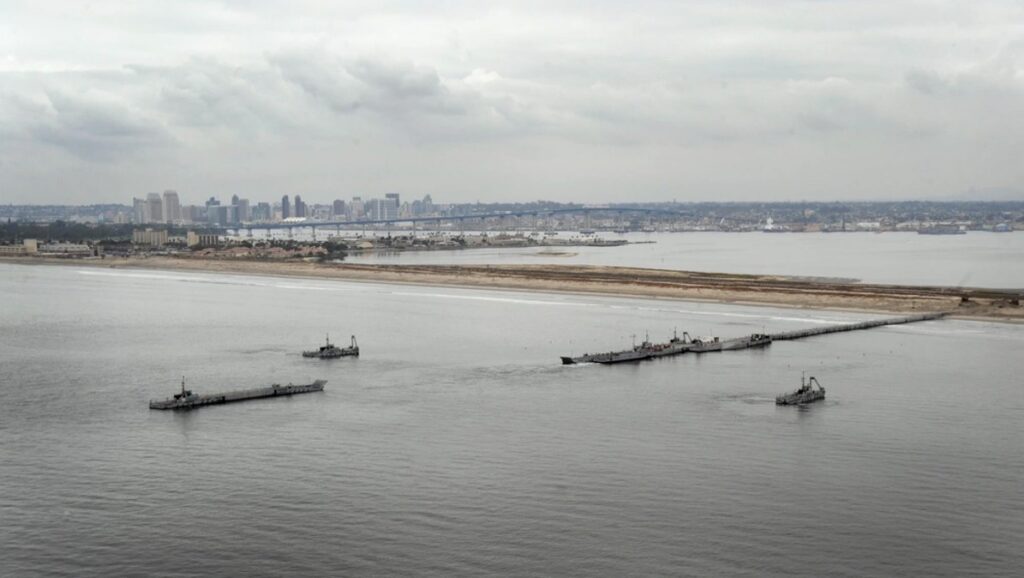
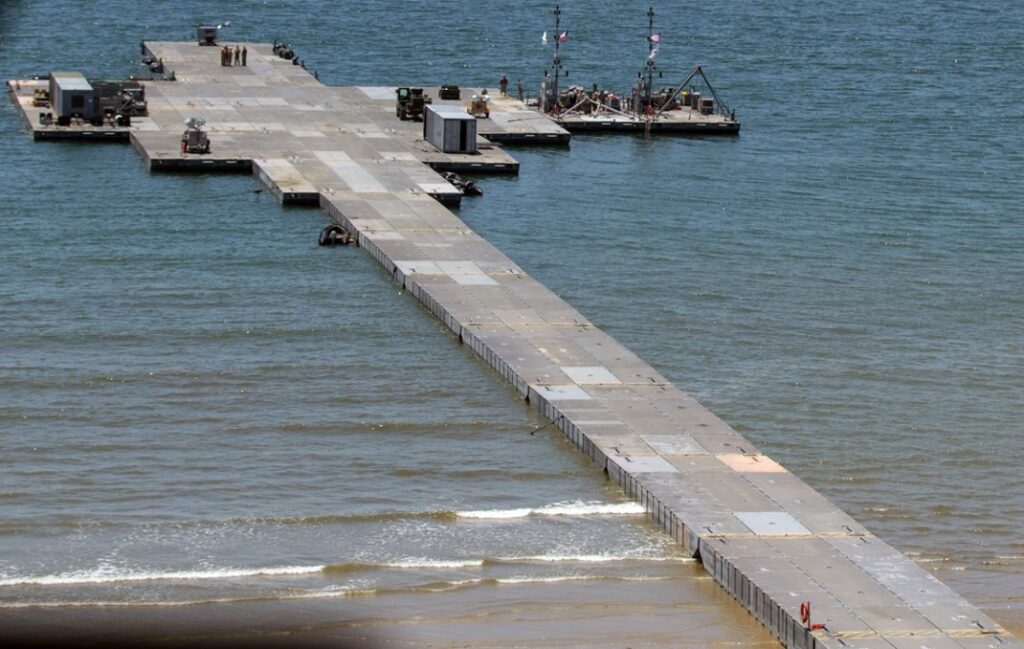
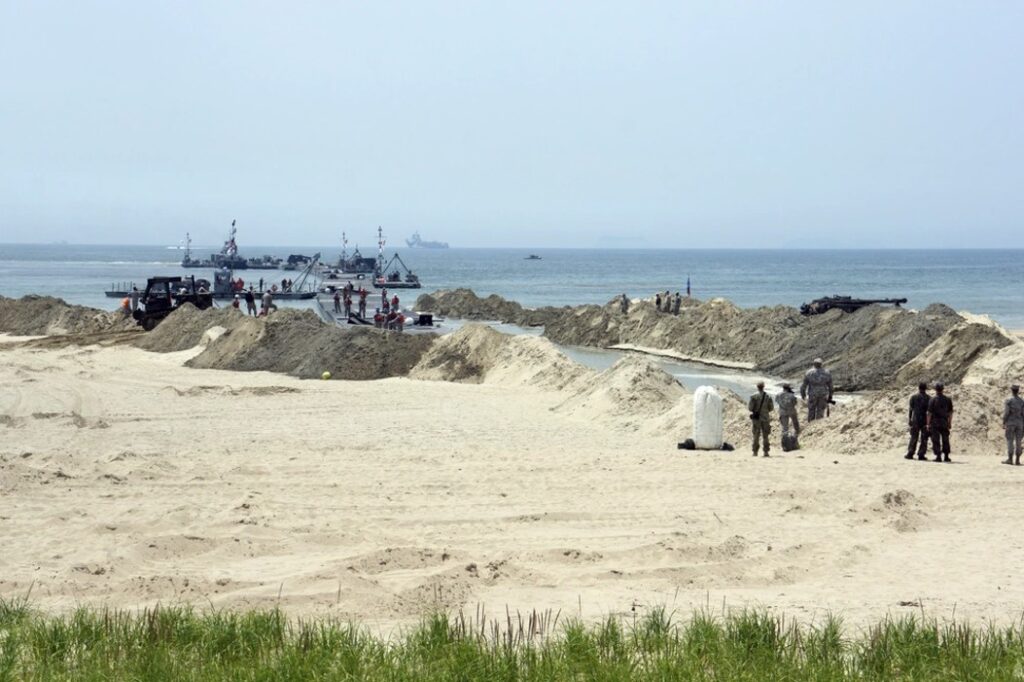

Jennifer Dyer is a retired U.S. Navy commander and a member of the JPC Board of Fellows. Her work can be found at The Optimistic Conservative: https://theoptimisticconservative.wordpress.com/

